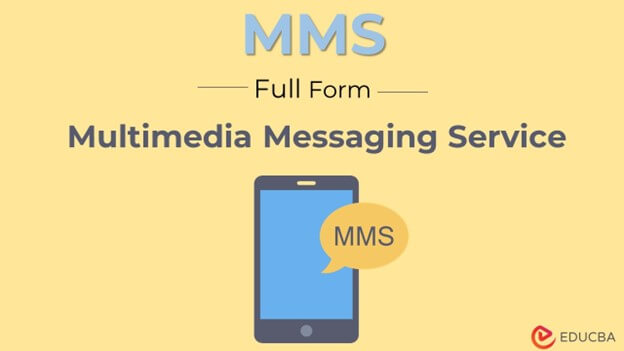What is the Full Form of MMS?
The full form of MMS is Multimedia Messaging Service (MMS). It is a mobile service that allows users to send and receive messages that include multimedia content such as images, audio, and video. MMS messages are sent over mobile phone networks and require compatible devices to be acquired and displayed.

Technical Description
MMS messages use a cellular network, which is preferable for multimedia content too large to be sent via SMS, such as a longer video or an image. MMS messages use Multimedia Messaging Protocol (MMP). The MMP is a protocol that allows for the transmission of multimedia content over a cellular network.
The protocol is based on the Session Initiation Protocol (SIP), a communications protocol used to establish, maintain, and terminate multimedia sessions. MMS messages will be transmitted over the cellular network through MMS packets. These packets contain multimedia content and other information, such as the sender’s and recipient’s phone numbers.
The MMS packets route to the recipient’s phone through the cellular network. Once the message is received, the multimedia content will display on the recipient’s phone. Cellular providers also use MMS messages to send their customers text messages, advertisements, and other content. For example, some providers may use MMS to send their customers promotional material or special offers.
Challenges
- Low Open Rates: Mobile marketing messages often have lower open rates than email, as people are less likely to open text messages from unknown senders.
- High Opt-Out Rates: Since people are less likely to opt-in to MMS messages, opt-out rates are often higher than other marketing types.
- Cost: Mobile marketing can be expensive due to the cost of the messages and the cost of developing and maintaining a mobile-friendly website.
- Limited Reach: MMS messages are limited to a certain number of characters, which can limit their reach.
- Low Conversion Rates: Conversion rates for MMS messages are often lower than other types of marketing due to the limited reach and opt-out rates.
- Privacy Concerns: Consumers are often concerned about the privacy implications of MMS messages, as they can contain personal information.
Interfaces
MMS, or Multimedia Messaging Service, is a mobile communication technology that allows users to send and receive multimedia messages. Interfaces used with MMS include:
- MMS Client: This is a software application installed on a mobile device that enables users to compose, send, receive, and view multimedia messages.
- Service Provider APIs are Application Programming Interfaces (APIs) offered by wireless service providers to enable third-party developers to create applications that can interact with the MMS service.
- Mobile Network Operator (MNO) Gateway: This is a gateway between the MMS client and the mobile service provider, which processes, stores, and forwards messages.
- Multimedia Messaging Service Center (MMSC): This server stores and forwards MMS messages.
Pros and Cons
Some of the pros and cons of MMS are listed below:-
Pros
- Quick Delivery: MMS messages are typically sent and received within seconds. It makes it ideal for those who need to communicate quickly and efficiently.
- Increased Engagement: MMS messages are often more engaging than SMS messages, as they contain multimedia elements such as images, videos, and audio clips. It can help keep recipients engaged and interested in the message.
- Improved Brand Recognition: MMS messages can increase brand recognition by including a company logo or other visuals to help promote the brand.
- Increased Response Rate: Studies have shown that MMS messages have a higher response rate than SMS messages. It can help businesses improve their customer engagement and conversions.
Cons
- Costly: MMS messages are typically more expensive than SMS messages, as they require more bandwidth. It can be a significant drawback for those with limited budgets.
- Limited File Size: MMS messages are limited in file size. It can be an issue for those who need to send large multimedia files.
- Incompatible Devices: Not all devices can receive MMS messages. It may be a problem for those who need to send messages to many recipients.
- Security Issues: MMS messages are not as secure as SMS messages, as malicious individuals can intercept them. It can be a significant concern for those who need to send sensitive information.
Conclusion
MMS is a great way to send multimedia messages quickly and securely. It sends photos, videos, audio notes, and other multimedia content quickly and securely. While technology has existed for some time, it is still growing in popularity and is being used more and more by businesses, organizations, and individuals. While there may be some security concerns, proper security measures will address these issues. In conclusion, MMS is a great way to send multimedia messages quickly and securely.
Recommended Articles
We hope that this EDUCBA information on “Full form of MMS” was beneficial to you. You can view EDUCBA’s recommended articles for more information,
